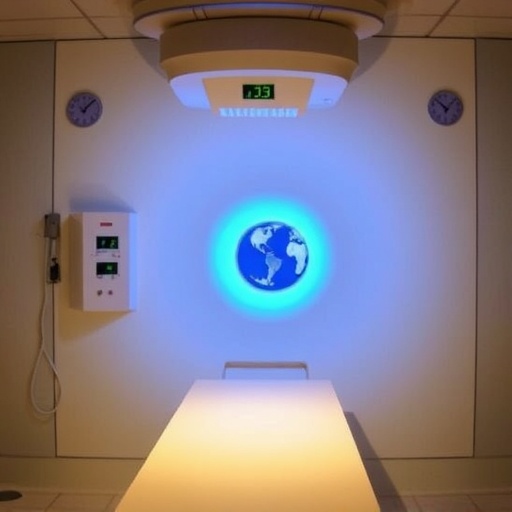For men undergoing radical prostatectomy to treat prostate cancer, the decision to follow surgery with radiation therapy can be a critical one. Postoperative radiation aims to minimize the risk that cancer cells remaining in the prostate bed may lead to recurrence. Yet, the conventional radiation regimen, typically involving daily treatments over several weeks, often causes patients to hesitate or decline this vital therapy. The time commitment and its associated burdens present significant barriers, hindering fully effective postoperative care.
A recent study, published in JAMA Oncology and spearheaded by investigators at the UCLA Health Jonsson Comprehensive Cancer Center, introduces a promising alternative: stereotactic body radiotherapy (SBRT). This approach delivers high doses of radiation in a drastically reduced timeframe—just five sessions instead of the conventional several weeks. The study’s findings reveal that SBRT is as safe as the traditional radiation treatments, producing comparable side effect profiles and maintaining patient quality of life over a two-year period.
This advancement signals a potential paradigm shift in postoperative prostate cancer therapy. Dr. Amar Kishan, executive vice chair of radiation oncology at UCLA’s David Geffen School of Medicine and the study’s senior author, emphasizes the implications: “SBRT shortens treatment time, reduces healthcare costs, and may have biological advantages in targeting prostate cancer.” UCLA’s pioneering work with SBRT in patients who have not undergone surgery now extends to post-radical prostatectomy cases, bolstered by the SCIMITAR trial—the first phase II data worldwide endorsing this treatment approach post-surgery.
SBRT’s success in intact prostate cancer cases is well-documented, demonstrating robust long-term tumor control paired with minimal adverse effects. However, its application post-radical prostatectomy has been limited due to anatomical and technical challenges. The prostate bed—the region where the prostate gland resided—is more difficult to target precisely because of its shifting position and proximity to essential healthy tissues after surgery. These concerns have historically restrained widespread experimentation or implementation in the post-surgical setting.
Technological breakthroughs in radiation delivery have now begun to overcome these obstacles. A key innovation is MRI-guided radiation therapy, which enhances treatment precision by providing superior soft tissue visualization and enabling real-time tracking of target movement during radiation sessions. These capabilities allow for smaller treatment margins, reducing collateral damage and side effects. The SCIMITAR study leveraged these improvements, seeking to determine whether SBRT could safely extend to men following prostate removal.
The trial enrolled 100 men who received SBRT after radical prostatectomy, closely monitoring their urinary, gastrointestinal, and sexual function over more than two years. Outcomes were benchmarked against a retrospective group of 200 patients treated conventionally. The data revealed that SBRT was not associated with an increase in side effects. Urinary complications of moderate severity occurred in roughly 25% of patients, while severe urinary symptoms were rare, affecting about 4%. Gastrointestinal side effects were similarly minimal, with moderate and severe incidences around 3% each. These figures closely mirror those reported for traditional radiation protocols, highlighting SBRT’s tolerability.
Importantly, patients undergoing SBRT reported no statistically significant differences in health-related quality of life compared to their counterparts receiving conventional radiation, even two years post-treatment. Quality of life assessments incorporated metrics addressing urinary control, bowel health, and sexual function, underscoring SBRT’s benign side effect profile. Moreover, the use of MRI guidance within SBRT further reduced gastrointestinal and late genitourinary adverse events, illustrating how refined imaging translates into safer therapy.
Dr. Kishan attributes the improved safety profile partly to the narrower planning target volume margins enabled by MRI guidance, reduced from the conventional 5 mm to just 3 mm. This tighter margin is achievable because MRI provides more accurate daily setup imaging and facilitates motion management through gating—temporarily suspending radiation when the target moves out of alignment. Such precision minimizes radiation exposure to surrounding organs, like the rectum and bladder, critically reducing toxicity.
Despite these encouraging results, the study authors caution that longer follow-up periods and additional trials are necessary to fully confirm that SBRT’s efficacy equals or surpasses that of conventional radiation in preventing cancer recurrence after prostatectomy. The ongoing EXCALIBUR trial, also led by UCLA investigators, is poised to provide pivotal long-term data. Furthermore, an update to the SCIMITAR trial featuring cancer control outcomes is anticipated later in the year, poised to clarify the treatment’s durability.
This study also reflects broader advancements in radiation oncology, where precision-targeted, high-dose treatments minimize side effects while maintaining efficacy. Innovations such as MRI guidance and motion management continue to unlock new applications for radiation therapy, enabling clinicians to adapt treatments to complex post-surgical anatomy—a domain traditionally fraught with challenges.
The SCIMITAR trial’s success owes much to a multidisciplinary team including UCLA residents, radiation oncologists, and researchers dedicated to refining prostate cancer therapy. The research received support from the National Institutes of Health and the Department of Defense, underscoring its scientific significance and potential public health impact. Collaboration across clinical disciplines and funding agencies remains crucial to transforming such cutting-edge treatments from experimental investigations into standard practice.
As data matures from ongoing studies, men facing prostate cancer surgery and their clinicians may soon have access to a faster, safer radiation therapy option that demands less time and disruption. In an era when patient-centered care and value-based medicine are paramount, these findings position SBRT as a compelling advancement, capable of improving outcomes while reducing treatment burden. The landscape of prostate cancer treatment may be on the cusp of a meaningful and welcome evolution.
Subject of Research: Postoperative radiation therapy for prostate cancer
Article Title: (Not explicitly provided in the content)
News Publication Date: (Not explicitly provided in the content)
Web References:
JAMA Oncology Article DOI: 10.1001/jamaoncol.2025.1059
UCLA Health Jonsson Comprehensive Cancer Center
References:
New Study Published in JAMA Oncology, SCIMITAR Phase II Trial Data, EXCALIBUR Trial (ongoing)
Keywords:
Prostate tumors, Prostate cancer, Radiation therapy, Cancer treatments, Medical treatments, Cancer research
Tags: advanced cancer treatment techniqueshealthcare costs in cancer treatmentJAMA Oncology study findingspatient quality of life prostate cancerpostoperative radiation therapyprostate cancer recurrence preventionprostate cancer treatmentradiation therapy side effectsradical prostatectomy recoveryshort-term radiation therapystereotactic body radiotherapy benefitsUCLA Health research advancements





